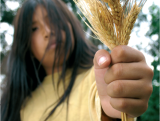The right approach to food security
Despite significant growth in global food production, 850 million people – nearly one-sixth of the world’s population – still suffer from chronic hunger. These millions, generally among developing countries’ most marginalized, do not have regular access to sufficient, nutritious food to support an active, healthy life. For them, food security is as scarce as their participation in political and economic decision-making, and their legal human right to food is far from being realized.
The rights-based approach offers a development alternative that can improve food security while recognizing human dignity and the inherent worth of every individual. Fostering an enabling environment that empowers people to feed themselves and their families, can unlock human potential and move away from the benevolence model of food aid.
Starting at the grassroots level, with the assumption that every human being has the right and the responsibility to feed themselves and their family, a rights-based approach can find the reasons why communities do not have enough to eat.. Perhaps farm land is not available, or those who have land may lack seeds or water. Perhaps jobs are unavailable, the pay too low, or markets have little or no food for sale. A rights-based approach is as much about the outcome – ending hunger and malnutrition – as it is about empowering people and ensuring a fair and transparent policy-making process to achieve these goals.
In 2004, the Right to Food Guidelines were adopted by FAO members to help realize this essential human right in their countries. While these guidelines provide an internationally accepted reference and checklist for government action, FAO’s newly established Right to Food Unit has tools and ideas ready to assist all interested stakeholders. When it comes to food security, we must all be interested, each one of us, because every human being is a stakeholder and a right to food rights-holder. Country work around the world has led to some key recommendations for an effective food security policy:
- create awareness and commitment at the highest political level for food and nutrition issues,
- generate and broaden the widest possible support for food and nutrition issues,
- take concerted action for food security involving not only agriculture and production sectors, but all government entities and stakeholders.
The Right to Food Unit has incorporated these recommendations into its work which it has centred on the following five areas of activity:
- Advocacy and Training – to make all stakeholders aware of their rights and obligations and to lobby for a rights-based approach in all policy areas – from land titling to primary education, from disease control to regulating fisheries.
- Information and Assessment – to identify the most vulnerable populations as well as what they require to establish food security for themselves and their communities
- Legislation and Accountability – to establish transparency, recourse mechanisms and avenues of appeal to help rights-holders establish their rights
- Strategy and Coordination – to bring policies and programmes affecting food in line with a people-centred and rights-based approach
- Benchmarks and Monitoring – to evaluate how governments and other stakeholders are progressing toward human rights goals
Incorporating human rights principles into traditional development approaches may supply the “missing element,” which some claim, has prevented 50 years of humanitarian aid from establishing food security and overcoming poverty. The World Food Day 2007 theme “The Right to Food”, provides an opportunity to focus global attention on this often overlooked human right.
We have the means to achieve full realization of the right to food for all. Now is the time to make it happen.
